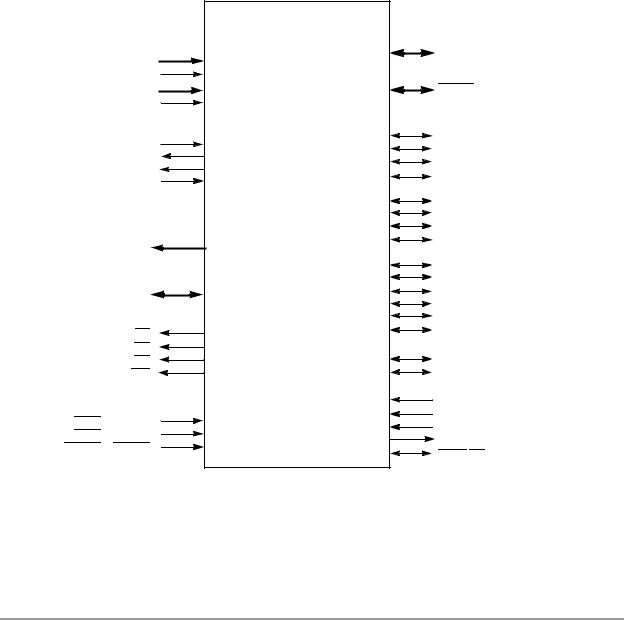
- •List of Figures
- •List of Tables
- •List of Examples
- •About This Book
- •1.1 DSP56824 Architecture Overview
- •1.1.1 DSP56824 Peripheral Blocks
- •1.1.1.1 On-Chip Memory
- •1.1.1.2 External Memory Interface (Port A)
- •1.1.1.3 General-Purpose Input/Output Port (Port B)
- •1.1.1.4 Programmable I/O Port (Port C)
- •1.1.1.5 Serial Peripheral Interface (SPI)
- •1.1.1.6 Synchronous Serial Interface (SSI)
- •1.1.1.7 General-Purpose Timer Module
- •1.1.1.8 On-Chip Clock Synthesis Block
- •1.1.1.9 COP/RTI Module
- •1.1.1.10 JTAG/OnCE™ Port
- •1.1.2 DSP56824 Peripheral Interrupts
- •1.2 DSP56800 Core Description
- •1.2.1 Data Arithmetic Logic Unit (Data ALU)
- •1.2.2 Address Generation Unit (AGU)
- •1.2.3 Program Controller and Hardware Looping Unit
- •1.2.4 Bit-Manipulation Unit
- •1.2.5 Address and Data Buses
- •1.2.6 On-Chip Emulation (OnCE) Module
- •1.3 DSP56800 Programming Model
- •1.4 Code Development on the DSP56824
- •2.1 Power and Ground Signals
- •2.2 Clock and Phase Lock Loop (PLL) Signals
- •2.3 External Memory Interface (Port A)
- •2.4 Interrupt and Mode Control Signals
- •2.5 GPIO Signals
- •2.6 Serial Peripheral Interface (SPI) Signals
- •2.7 Synchronous Serial Interface (SSI) Signals
- •2.8 Timer Module Signals
- •2.9 JTAG/OnCE Port Signals
- •3.1 DSP56824 Memory Map
- •3.1.1 X Data Memory
- •3.1.2 Operating Mode Register (OMR)
- •3.1.2.1 Nested Looping (NL)—Bit 15
- •3.1.2.2 Reserved Bits—Bits 14–9
- •3.1.2.3 Condition Codes (CC)—Bit 8
- •3.1.2.4 Reserved Bit—Bit 7
- •3.1.2.5 Stop Delay (SD)—Bit 6
- •3.1.2.6 Rounding (R)—Bit 5
- •3.1.2.7 Saturation (SA)—Bit 4
- •3.1.2.8 External X Memory (EX)—Bit 3
- •3.1.2.9 Reserved Bit—Bit 2
- •3.1.3 DSP56824 Status Register (SR)
- •3.1.4 On-Chip Peripheral Memory Map
- •3.1.5 Program Memory Map
- •3.2 DSP56824 Operating Modes
- •3.2.1 Single Chip Bootstrap Mode (Mode 0)
- •3.2.2 Single Chip User (Mode 1)
- •3.2.3 Normal Expanded Mode (Mode 2)
- •3.2.4 Development Mode (Mode 3)
- •3.3 DSP56824 Reset and Interrupt Vectors
- •3.3.1 DSP56824 Interrupt Priority Register (IPR)
- •3.3.2 Interrupt Priority Structure
- •4.1 External Memory Port Architecture
- •4.2 Port A Description
- •4.2.1 Bus Control Register (BCR)
- •4.2.1.1 Reserved Bits—Bits 15–10
- •4.2.1.2 Drive (DRV)—Bit 9
- •4.2.1.3 Reserved Bit—Bit 8
- •4.2.2 Pins in Different Processing States
- •5.1 Port B Programming Model
- •5.1.1 Port B Data Direction Register (PBDDR)
- •5.1.2 Port B Data (PBD) Register
- •5.1.2.1 PBD Bit Values for General-Purpose Inputs
- •5.1.2.2 PBD Bit Values for General-Purpose Outputs
- •5.1.2.3 PBD Bit Values for Interrupt Inputs
- •5.1.3 Port B Interrupt (PBINT) Register
- •5.2 Port B Interrupt Generation
- •5.3 Port B Programming Examples
- •5.3.1 Receiving Data on Port B
- •5.3.2 Sending Data on Port B
- •5.3.3 Looping Data on Port B
- •5.3.4 Generating Interrupts on Port B
- •6.1 Port C Programming Model
- •6.1.1 Port C Control (PCC) Register
- •6.1.2 Port C Data Direction Register (PCDDR)
- •6.1.3 Port C Data (PCD) Register
- •6.2 Port C Programming Examples
- •6.2.1 Receiving Data on Port C GPIO Pins
- •6.2.2 Sending Data on Port C GPIO Pins
- •6.2.3 Looping Data on Port C GPIO Pins
- •7.1 SPI Architecture
- •7.2 SPI Programming Model
- •7.2.1 SPI Control Registers (SPCR0 and SPCR1)
- •7.2.1.1 Reserved Bits—Bits 15–9
- •7.2.1.2 SPI Clock Rate Select (SPR[2:0])—Bits 8, 1–0
- •7.2.1.3 SPI Interrupt Enable (SPIE)—Bit 7
- •7.2.1.4 SPI Enable (SPE)—Bit 6
- •7.2.1.5 Wired-OR Mode (WOM)—Bit 5
- •7.2.1.6 Master Mode Select (MST)—Bit 4
- •7.2.1.7 Clock Polarity (CPL)—Bit 3
- •7.2.1.8 Clock Phase (CPH)—Bit 2
- •7.2.2 SPI Status Register (SPSR0 and SPSR1)
- •7.2.2.1 Reserved Bits—Bits 15–8
- •7.2.2.2 SPI Interrupt Complete Flag (SPIF)—Bit 7
- •7.2.2.3 Write Collision (WCOL)—Bit 6
- •7.2.2.4 Reserved Bit—Bit 5
- •7.2.2.5 Mode Fault (MDF)—Bit 4
- •7.2.2.6 Reserved Bits—Bits 3–0
- •7.2.3 SPI Data Registers (SPDR0 and SPDR1)
- •7.3 SPI Data and Control Pins
- •7.4 SPI System Errors
- •7.4.1 SPI Mode-Fault Error
- •7.4.2 SPI Write-Collision Error
- •7.4.3 SPI Overrun
- •7.5 Configuring Port C for SPI Functionality
- •7.6 Programming Examples
- •7.6.1 Configuring an SPI Port as Master
- •7.6.2 Configuring an SPI Port as Slave
- •7.6.3 Sending Data from Master to Slave
- •8.1 SSI Architecture
- •8.1.1 SSI Clocking
- •8.1.2 SSI Clock and Frame Sync Generation
- •8.2 SSI Programming Model
- •8.2.1 SSI Transmit Shift Register (TXSR)
- •8.2.2 SSI Transmit Data Buffer Register
- •8.2.3 SSI Transmit Data (STX) Register
- •8.2.4 SSI Receive Shift Register (RXSR)
- •8.2.5 SSI Receive Data Buffer Register
- •8.2.6 SSI Receive Data (SRX) Register
- •8.2.7 SSI Transmit and Receive Control Registers
- •8.2.7.1 Prescaler Range (PSR)—Bit 15
- •8.2.7.2 Word Length Control (WL[1:0])—Bits 14–13
- •8.2.7.3 Frame Rate Divider Control (DC[4:0])—Bits 12–8
- •8.2.7.4 Prescale Modulus Select (PM[7:0])—Bits 7–0
- •8.2.8 SSI Control Register 2 (SCR2)
- •8.2.8.1 Receive Interrupt Enable (RIE)—Bit 15
- •8.2.8.2 Transmit Interrupt Enable (TIE)—Bit 14
- •8.2.8.3 Receive Enable (RE)—Bit 13
- •8.2.8.4 Transmit Enable (TE)—Bit 12
- •8.2.8.5 Receive Buffer Enable (RBF)—Bit 11
- •8.2.8.6 Transmit Buffer Enable (TBF)—Bit 10
- •8.2.8.7 Receive Direction (RXD)—Bit 9
- •8.2.8.8 Transmit Direction (TXD)—Bit 8
- •8.2.8.9 Synchronous Mode (SYN)—Bit 7
- •8.2.8.10 Transmit Shift Direction (TSHFD)—Bit 6
- •8.2.8.11 Transmit Clock Polarity (TSCKP)—Bit 5
- •8.2.8.12 SSI Enable (SSIEN)—Bit 4
- •8.2.8.13 Network Mode (NET)—Bit 3
- •8.2.8.14 Frame Sync Invert (FSI)—Bit 2
- •8.2.8.15 Frame Sync Length (FSL)—Bit 1
- •8.2.8.16 Early Frame Sync (EFS)—Bit 0
- •8.2.9 SSI Control/Status Register (SCSR)
- •8.2.9.1 Reserved Bit—Bit 15
- •8.2.9.2 Receive Shift Direction (RSHFD)—Bit 14
- •8.2.9.3 Receive Clock Polarity (RSCKP)—Bit 13
- •8.2.9.4 Reserved Bits—Bits 12–11
- •8.2.9.5 Receive Frame Sync Invert (RFSI)—Bit 10
- •8.2.9.6 Receive Frame Sync Length (RFSL)—Bit 9
- •8.2.9.7 Receive Early Frame Sync (REFS)—Bit 8
- •8.2.9.8 Receive Data Register Full (RDF)—Bit 7
- •8.2.9.9 Transmit Data Register Empty (TDE)—Bit 6
- •8.2.9.10 Receiver Overrun Error (ROE)—Bit 5
- •8.2.9.11 Transmitter Underrun Error (TUE)—Bit 4
- •8.2.9.12 Transmit Frame Sync (TFS)—Bit 3
- •8.2.9.13 Receive Frame Sync (RFS)—Bit 2
- •8.2.9.14 Receive Data Buffer Full (RDBF)—Bit 1
- •8.2.9.15 Transmit Data Buffer Empty (TDBE)—Bit 0
- •8.2.10 SSI Time Slot Register (STSR)
- •8.3 SSI Data and Control Pins
- •8.4 SSI Operating Modes
- •8.4.1 Normal Mode
- •8.4.1.1 Normal Mode Transmit
- •8.4.1.2 Normal Mode Receive
- •8.4.2 Network Mode
- •8.4.2.1 Network Mode Transmit
- •8.4.2.2 Network Mode Receive
- •8.4.3 Gated Clock Operation
- •8.5 SSI Reset and Initialization Procedure
- •8.6 Configuring Port C for SSI Functionality
- •9.1 Timer Programming Model
- •9.1.1 Timer Control Registers (TCR01 and TCR2)
- •9.1.1.1 Timer Enable (TE)—Bit 15, Bit 7
- •9.1.1.2 Invert (INV)—Bit 6
- •9.1.1.3 Overflow Interrupt Enable (OIE)—Bit 12, Bit 4
- •9.1.1.4 Timer Output Enable (TO[1:0])—Bits 11–10, Bits 3–2
- •9.1.1.5 Event Select (ES[1:0])—Bits 9–8, Bits 1–0
- •9.1.1.6 Reserved TCR Bits
- •9.1.2 Timer Preload Register (TPR)
- •9.1.3 Timer Count Register (TCT)
- •9.2 Timer Resolution
- •9.3 Timer Interrupt Priorities
- •9.4 Event Counting with the Timer Module
- •9.5 Timer Module Low-Power Operation
- •9.5.1 Turning Off the Entire Timer Module
- •9.5.2 Turning Off Any Timer Not in Use
- •9.5.3 Lowering the Timer Frequency
- •9.5.4 Running the Timer in Wait Mode
- •9.5.5 Running the Timer in Stop Mode
- •9.6 Timer Module Timing Diagrams
- •9.7 Configuring Port C for Timer Functionality
- •10.1 Timing System Architecture
- •10.1.1 Oscillator
- •10.1.2 Phase Lock Loop (PLL)
- •10.1.3 Prescaler
- •10.1.4 Clockout Multiplexer (MUX)
- •10.1.5 Control Registers
- •10.2 Clock Synthesis Programming Model
- •10.2.1 PLL Control Register 1 (PCR1)
- •10.2.1.1 Reserved Bit—Bit 15
- •10.2.1.2 PLL Enable (PLLE)—Bit 14
- •10.2.1.3 PLL Power Down (PLLD)—Bit 13
- •10.2.1.4 Low Power Stop (LPST)—Bit 12
- •10.2.1.5 Test Enable (TSTEN)—Bit 11
- •10.2.1.6 Prescaler Divider (PS[2:0])—Bits 10–8
- •10.2.1.7 CLKO Select (CS[1:0])—Bits 7–6
- •10.2.1.8 Reserved Bits—Bits 5–4
- •10.2.1.9 VCO Curve Select (VCS0)—Bit 3
- •10.2.1.10 Reserved Bits—Bits 2–0
- •10.2.2 PLL Control Register 0 (PCR0)
- •10.2.2.1 Reserved Bit—Bit 15
- •10.2.2.2 Feedback Divider (YD[9:0])—Bits 14–5
- •10.2.2.3 Reserved Bits—Bits 4–0
- •10.3 Low-Power Wait and Stop Modes
- •10.3.2 COP, Realtime Clock and CLKO Pin Enabled
- •10.3.3 PLL and CLKO Pin Enabled
- •10.3.4 CLKO Pin Enabled
- •10.3.5 Everything Disabled
- •10.4 PLL Lock
- •10.4.1 PLL Programming Example
- •10.4.2 Changing the PLL Frequency
- •10.4.3 Turning Off the PLL Before Entering Stop Mode
- •10.5 PLL Module Low-Power Operation
- •10.5.1 Turning Off the Entire Clock Synthesis Module
- •10.5.2 Turning Off the Prescaler Divider When Not in Use
- •10.5.3 Turning Off the PLL When Not in Use
- •10.5.4 Turning Off the CLKO Pin When Not in Use
- •11.1 COP and Real-Time Timer Architecture
- •11.2 COP and RTI Timer Programming Model
- •11.2.1 COP and RTI Control Register (COPCTL)
- •11.2.1.1 COP Enable (CPE)—Bit 15
- •11.2.1.2 COP Timer Divider (CT)—Bit 14
- •11.2.1.3 Reserved Bits—Bits 13–12
- •11.2.1.4 RTI Timer Enable (RTE)—Bit 11
- •11.2.1.5 RTI Enable (RTIE)—Bit 10
- •11.2.1.6 RTI Flag (RTIF)—Bit 9
- •11.2.1.7 RTI Prescaler (RP)—Bit 8
- •11.2.1.8 RTI/COP Divider (DV[7:0])—Bits 7–0
- •11.2.2 COP and RTI Count (COPCNT) Register
- •11.2.2.1 Reserved Bits—Bits 15–13
- •11.2.2.2 RTI/COP Divider (DV[7:0])—Bits 12–5
- •11.2.2.3 RTI Prescaler (RP[1:0])—Bits 4–3
- •11.2.2.4 Scaler (SC[2:0])—Bits 2–0
- •11.2.3 COP Reset (COPRST) Register
- •11.3 Programming the COP and RTI Timers
- •11.3.1 COP and RTI Timer Resolution
- •11.3.2 COP/RTI Timer Low-Power Operation
- •11.3.3 Programming Example
- •12.1 Combined JTAG/OnCE Interface Overview
- •12.2 JTAG/OnCE Port Pinout
- •12.3 OnCE Module Architecture
- •12.3.1 OnCE Port Block Diagram
- •12.3.2 OnCE Programming Model
- •12.3.3 OnCE State Machine and Control Block
- •12.4 Command, Status, and Control Registers
- •12.4.1 OnCE Shift Register (OSHR)
- •12.4.2 OnCE Command Register (OCMDR)
- •12.4.3 OnCE Decoder (ODEC)
- •12.4.4 OnCE Control Register (OCR)
- •12.4.4.1 COP Timer Disable (COPDIS)—Bit 15
- •12.4.4.2 DE Pin Output Enable (DE)—Bit 14
- •12.4.4.3 Breakpoint Configuration (BK[4:0])—Bits 13–9
- •12.4.4.4 Debug Request Mask (DRM)—Bit 8
- •12.4.4.5 FIFO Halt (FH)—Bit 7
- •12.4.4.6 Event Modifier (EM[1:0])—Bits 6–5
- •12.4.4.7 Power Down Mode (PWD)—Bit 4
- •12.4.4.8 Breakpoint Selection (BS[1:0])—Bits 3–2
- •12.4.4.9 Breakpoint Enable (BE[1:0])—Bits 1–0
- •12.4.5 OnCE Breakpoint 2 Control Register (OBCTL2)
- •12.4.5.1 Reserved OBCTL2 Register Bits
- •12.4.5.2 Enable (EN)—Bit 2
- •12.4.5.3 Invert (INV)—Bit 1
- •12.4.5.4 Data/Address Select (DAT)—Bit 0
- •12.4.6 OnCE Status Register (OSR)
- •12.4.6.1 Reserved OSR Bits—Bits 7–5
- •12.4.6.2 OnCE Core Status (OS[1:0])—Bits 4–3
- •12.4.6.3 Trace Occurrence (TO)—Bit 2
- •12.4.6.4 Hardware Breakpoint Occurrence (HBO)—Bit 1
- •12.4.6.5 Software Breakpoint Occurrence (SBO)—Bit 0
- •12.5 Breakpoint and Trace Registers
- •12.5.1 OnCE Breakpoint/Trace Counter Register (OCNTR)
- •12.5.2 OnCE Memory Address Latch (OMAL) Register
- •12.5.3 OnCE Breakpoint Address Register (OBAR)
- •12.5.4 OnCE Memory Address Comparator (OMAC)
- •12.5.5 OnCE Breakpoint and Trace Section
- •12.6 Pipeline Registers
- •12.6.1 OnCE PAB Fetch Register (OPABFR)
- •12.6.2 OnCE PAB Decode Register (OPABDR)
- •12.6.3 OnCE PAB Execute Register (OPABER)
- •12.6.4 OnCE PAB Change-of-Flow FIFO (OPFIFO)
- •12.6.5 OnCE PDB Register (OPDBR)
- •12.6.6 OnCE PGDB Register (OPGDBR)
- •12.6.7 OnCE FIFO History Buffer
- •12.7 Breakpoint 2 Architecture
- •12.8 Breakpoint Configuration
- •12.8.1 Programming the Breakpoints
- •12.8.2 OnCE Trace Logic Operation
- •12.9 The Debug Processing State
- •12.9.1 OnCE Normal, Debug, and Stop Modes
- •12.9.2 Entering Debug Mode
- •12.9.2.1 JTAG DEBUG_REQUEST and the Debug Event Pin
- •12.9.2.2 Software Request During Normal Activity
- •12.9.2.3 Trigger Events (Breakpoints and Trace Modes)
- •12.9.2.5 Exiting Debug Mode
- •12.10 Accessing the OnCE Module
- •12.10.1 Primitive JTAG Sequences
- •12.10.2 Entering the JTAG Test-Logic-Reset State
- •12.10.3 Loading the JTAG Instruction Register
- •12.10.4 Accessing a JTAG Data Register
- •12.10.4.1 JTAG/OnCE Interaction: Basic Sequences
- •12.10.4.2 Executing a OnCE Command by Reading the OCR
- •12.10.4.3 Executing a OnCE Command by Writing the OCNTR
- •12.10.4.4 OSR Status Polling
- •12.10.4.5 JTAG IR Status Polling
- •12.10.4.6 TRST/DE Pin Polling
- •12.10.5 Serial Protocol Description
- •12.10.5.1 Entering Debug Mode from User Mode
- •12.10.5.2 Entering Debug Mode from DSP Reset
- •12.10.5.3 Polling for OnCE Status
- •12.10.5.4 Setting Breakpoints in User Mode
- •12.10.5.5 Reading Pipeline Information in User Mode
- •12.10.5.6 Displaying a Specified Register
- •12.10.5.7 Displaying X Memory Area Starting at Address xxxx
- •12.10.5.8 Returning from Debug Mode to Normal Mode
- •12.10.5.9 Recovering from STOP or WAIT Execution
- •12.11 Using the OnCE Port
- •12.11.1 Beginning Debug Activity
- •12.11.2 Displaying a Specified Register
- •12.11.3 Displaying X Memory Area Starting at Address xxxx
- •12.11.4 Returning from Debug Mode to Normal Mode
- •12.12 OnCE Unit Low-Power Operation
- •13.1 JTAG/OnCE Port Pinout
- •13.2 JTAG Port Architecture
- •13.2.1 JTAG Instruction Register (IR) and Decoder
- •13.2.2 JTAG Chip Identification (CID) Register
- •13.2.3 JTAG Boundary Scan Register (BSR)
- •13.2.4 JTAG Bypass Register
- •13.3 TAP Controller
- •13.4 DSP56824 Restrictions
- •A.1 Design Considerations
- •A.1.1 Boot Source Selection
- •A.1.1.1 Bootstrapping from SPI0
- •A.1.1.2 Bootstrapping from Port A
- •A.1.2 COP Reset
- •A.1.3 No Load Option
- •A.2 Bootstrap Listing
- •B.1 DSP56824 BSDL Listing—100-Pin TQFP
- •C.1 Instruction Set Summary
- •C.2 Interrupt, Vector, and Address Tables
- •C.3 Programmer’s Sheets
- •Index

DSP56824 Overview
1.4 Code Development on the DSP56824
The DSP56824 instruction set, described in detail in the DSP56800 Family Manual, provides assembly-level programming for this product. This manual provides a number of samples of source code to demonstrate the programming of certain features. These examples are not comprehensive; they are only a sampling of what is possible. See the DSP56800 Family Manual for more information on development hardware and software products for the DSP56824, including an Application Development System (ADS) that allows access to most DSP56824 functions and peripherals.
Two mechanisms on the DSP56824 aid code development—full access by all instructions to the external data bus and OnCE module hooks. The first is useful when code is first being developed on a hardware platform using external program memory. This section describes this first option. The OnCE module is fully described in Chapter 12, “OnCE™ Module.”
Instructions on the DSP56824 can be executed without regard for whether the instruction fetch is on-chip or off-chip and whether any data access is on-chip or off-chip. However, executing an instruction (including parallel moves) may require as many as three memory accesses. If more than one of these memory accesses occurs off-chip, an additional instruction cycle is required for every external access because only one access to external memory can occur at a time. This is shown in Example 1-1 and in the following discussion.
Example 1-1. On-Chip and Off-Chip Instruction Fetches
mac x0,y0,a x:(r0)+,y0 x:(r3)+,x0
The various permutations of memory accesses that may be represented in Example 1-1 are:
•Case 1—Instruction located on-chip, both x:() data accesses performed to on-chip memory
In this case, because all memories are located on-chip, no external accesses are performed and the instruction runs in one instruction cycle, correctly performing all three accesses to on-chip memory.
•Case 2—Instruction located off-chip, both x:() data accesses performed to on-chip memory
In this case, only one external memory access occurs off-chip. The instruction fetch occurs over the external bus, and the data accesses are made to on-chip memory. The instruction still runs in one instruction cycle, correctly performing all three accesses.
•Case 3—Instruction located on-chip, one x:() data access performed to off-chip memory
In this case, only one external memory access occurs off-chip. The instruction fetch is done to on-chip memory, one data access occurs over the external bus, and one data access is done to on-chip memory. The instruction still runs in one instruction cycle, correctly performing all three accesses.
•Case 4—Instruction located off-chip, one x:() data access performed to off-chip memory
In this case, two external memory accesses occur off-chip. The instruction fetch occurs over the external bus, followed by the external data access. A data access to internal memory also takes place. The instruction now runs in two instruction cycles, correctly performing all three accesses.
Case 4 is often used during code development to provide the best visibility. This feature allows a logic analyzer to be placed on the external bus during code development on target hardware so that all memory accesses are visible. Separate PS and DS pins are provided to indicate whether the access is to external program or data memory.
1-12 |
DSP56824 User’s Manual |
|

Code Development on the DSP56824
NOTE:
In this mode, accesses to on-chip peripherals are not visible because these memory-mapped registers are on-chip.
An example of a system where all program and memory accesses are visible is shown in Figure 1-5.
DSP56824
 MODA/IRQA
MODA/IRQA
MODB/IRQB
64K SRAM
PS |
|
DS |
A15 |
ADR |
A14–A0 |
DATA |
DATA |
To Logic Analyzer |
AA0127 |
Figure 1-5. Code Development with Visibility on All Memory Accesses
In this example, the DSP56824 is programmed for operating mode 3 (development mode) in the operating mode register (OMR) to specify that all program accesses are performed externally. See Section 3.1, “DSP56824 Memory Map,” on page 3-1 for a detailed description of the OMR. Likewise, the EX bit (in the OMR) is set to specify that data accesses are performed externally. An exception to this is the second access on any instruction that performs two reads in a single instruction. In this case, the second read using the R3 pointer always occurs to on-chip memory. If this is an issue, the instruction performing two data memory reads can be replaced by two instructions, each performing one of the two data memory accesses.
DSP56824 Overview |
1-13 |

DSP56824 Overview
1-14 |
DSP56824 User’s Manual |
|

Chapter 2
Signal Descriptions
The input and output signals of the DSP56824 are organized into functional groups, as shown in Table 2-1 on page 2-2 and as illustrated in Figure 2-1. In Table 2-2 on page 2-3 through Table 2-14 on page 2-12, each row describes the signal or signals present on an individual pin. Note that some pins can carry more than one signal, depending on chip configuration.
|
|
|
|
DSP56824 |
|
|
|
|
|
|
Port B |
|
Port B GPIO |
|
|
|
|
Programmable |
8 |
|
|
|
|
|
|
||
|
|
9 |
|
Interrupts/GPIO |
PB0–PB7 |
|
|
VDD |
Power |
|
|||
|
VDDPLL |
9 |
Port |
Dedicated |
8 |
|
|
VSS |
|
PB8–PB14 |
|||
|
Ground |
GPIO |
XCOLF |
|||
|
VSSPLL |
|
PB15 |
|||
|
|
|
|
|
||
|
|
|
|
|
|
Port C GPIO |
|
EXTAL |
|
|
Port C |
MISO0 |
PC0 |
|
|
|
SPI0 Port/ |
MOSI0 |
PC1 |
|
|
XTAL |
|
PLL and |
|||
|
|
SCK0 |
PC2 |
|||
|
|
GPIO |
||||
|
CLKO |
|
Clock |
|||
|
|
SS0 |
PC3 |
|||
|
|
|
||||
|
SXFC |
|
|
|
||
|
|
|
|
|
|
|
|
|
|
|
SPI1 Port/ |
MISO1 |
PC4 |
|
|
|
Port A |
MOSI1 |
PC5 |
|
|
|
|
GPIO |
|||
|
|
16 |
External |
SCK1 |
PC6 |
|
|
|
|
||||
|
A0–A15 |
|
SS1 |
PC7 |
||
|
|
Address |
|
|||
|
|
|
Bus |
|
STD |
PC8 |
|
|
|
|
|
||
|
D0–D15 |
16 |
External |
SSI Port/ |
SRD |
PC9 |
|
|
Data |
GPIO |
STCK |
PC10 |
|
|
|
|
Bus |
|
STFS |
PC11 |
|
PS |
|
|
|
SRCK |
PC12 |
|
|
External |
|
SRFS |
PC13 |
|
|
DS |
|
|
|
|
|
|
|
Bus |
Timer Module/ |
|
|
|
|
RD |
|
TIO01 |
PC14 |
||
|
|
Control |
GPIO |
|||
|
WR |
|
TIO2 |
PC15 |
||
|
|
|
|
|||
After |
During |
|
|
|
TCK |
|
Reset |
Reset |
|
|
JTAG/ |
|
|
|
|
TMS |
|
|||
IRQA |
MODA |
|
Interrupt/ |
|
||
|
OnCE |
TDI |
|
|||
IRQB |
MODB |
|
Mode |
|
||
|
Port |
TDO |
|
|||
RESET |
RESET |
|
Control |
|
||
|
|
TRST/DE |
|
|||
|
|
|
|
|
AA1431 |
|
|
|
|
|
|
|
|
|
Figure 2-1. DSP56824 Functional Group Pin Allocations |
|
||||
Signal Descriptions |
2-1 |

Signal Descriptions
The interface signals have the following general characteristics:
•The following pins are pulled high with a weak on-chip resistor: TDI, TMS, and TRST/DE.
•The following pins are pulled high by the DSP during hardware reset (assertion of RESET): PS, DS, RD, WR, and XCOLF/PB15.
•The following pins can be pulled high by the DSP during the JTAG EXTEST_PULLUP instruction: EXTAL, D0–D15, PB0–PB15, PC0–PC15, MODA/IRQA, MODB/IRQB, and RESET.
•All unused port pins configured as inputs should be properly terminated through a pull-up resistor except for pins that are tied to an internal pull-up or pull-down resistor. All power and ground pins should be connected to the appropriate low-impedance power and ground paths.
The I/O signals are organized into the functional groups, as summarized in Table 2-1.
Table 2-1. Functional Group Pin Allocations
Functional Group |
Number of |
Detailed Description |
|
Pins |
|||
|
|
||
|
|
|
|
|
|
|
|
Power (VDD or VDDPLL) |
10 |
Table 2-2 on page 2-3 |
|
|
|
|
|
Ground (VSS or VSSPLL) |
10 |
Table 2-3 on page 2-3 |
|
|
|
|
|
Clock and phase lock loop (PLL) |
4 |
Table 2-4 on page 2-3 |
|
|
|
|
|
Address bus |
16 |
Table 2-5 on page 2-4 |
|
|
|
|
|
Data bus |
16 |
Table 2-6 on page 2-4 |
|
|
|
|
|
Bus control |
4 |
Table 2-7 on page 2-4 |
|
|
|
|
|
Interrupt and mode control |
3 |
Table 2-8 on page 2-5 |
|
|
|
|
|
Programmable interrupt general-purpose input/output |
8 |
Table 2-9 on page 2-6 |
|
|
|
|
|
Dedicated general-purpose input/output |
8 |
Table 2-10 on page 2-7 |
|
|
|
|
|
Serial peripheral interface (SPI) ports * |
8 |
Table 2-11 on page 2-7 |
|
|
|
|
|
Synchronous serial interface (SSI) port * |
6 |
Table 2-12 on page 2-10 |
|
|
|
|
|
Timer module* |
2 |
Table 2-13 on page 2-11 |
|
|
|
|
|
JTAG/OnCE |
5 |
Table 2-14 on page 2-12 |
|
|
|
|
|
Note: *Alternately, general-purpose I/O pins |
|
|
|
|
|
|
2-2 |
DSP56824 User’s Manual |
|
